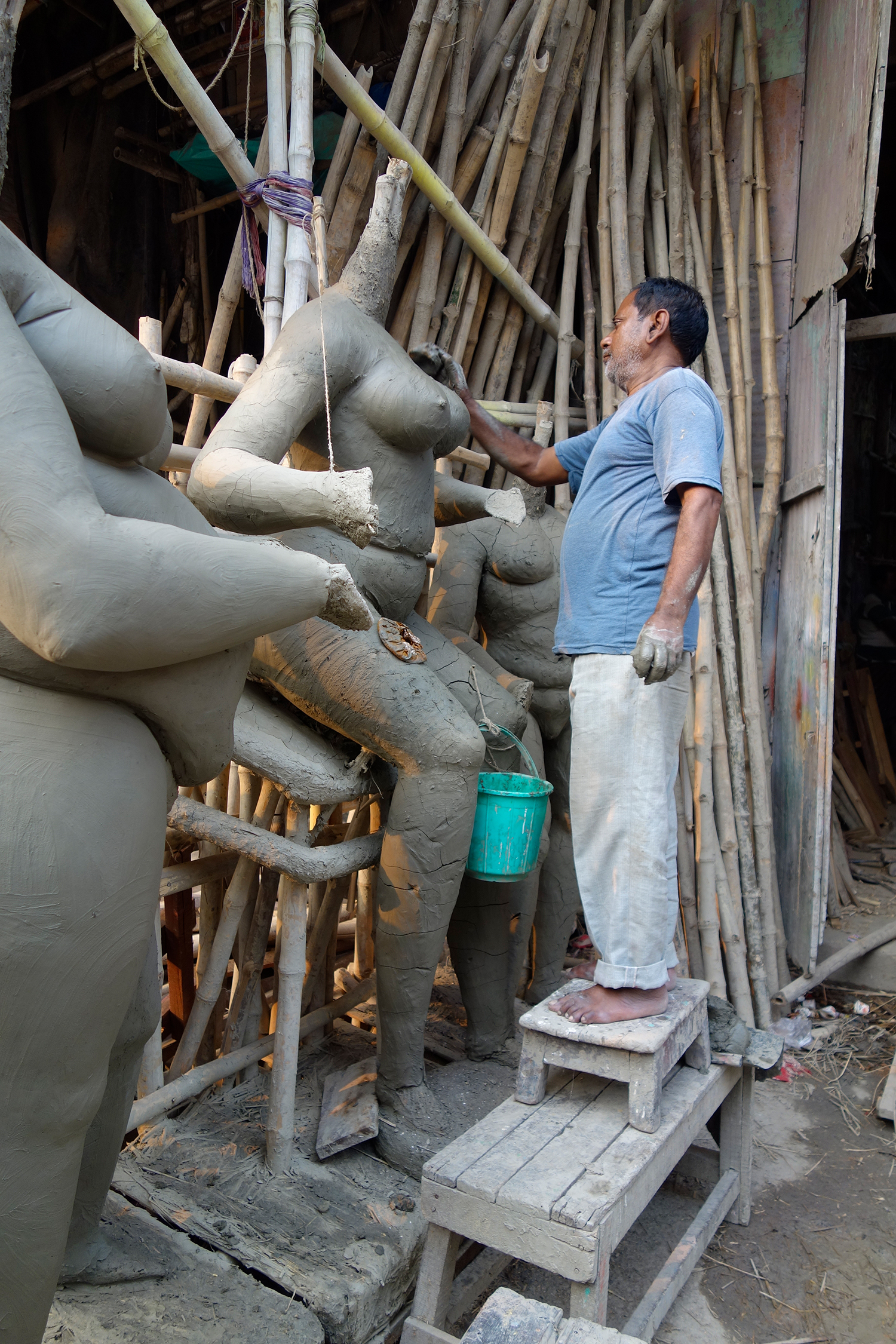SURFACE
LEVEL OVERVIEW
Naba’s workshop is organised like many here. Similar to a batch production approach, the whole process is divided with different parts delegated to different craftsmen (they are all men in this workshop) depending on their skill level and time employed.
One person is responsible for breaking up palette wood to make base frames and supports to hold the idol forms. The size of the figure being produced affects whether the wooden structure of the armature is a single stake or something more involved, though still very rudimentary, out of the palette wood and bamboo.
Another person looks after the mixing of the clay to the various different consistencies required for the different modelling stages. Then there are two or three people that construct the straw armatures and model the clay. (These numbers swell in the build-up to Durga Puja but I am here at a quiet part of the year.) Finally, the clay forms, once dry, must be painted and then dressed. Each idol has specific clothing and weapons. Jewellery and garlands complete the look. The items for the latter decorative work are produced in specialist neighbouring workshops.
The application of the clay to the straw armature happens in stages. There is a rough undercoat, clay mixed with rice husks, that is first applied to the straw core. This coarse texture better grips the surface. Gaps can be filled more quickly and the natural undulations of the straw of the armature, which is bound with string, smoothed. The ‘skin’ of the figure is then built up out of clay of a more standard and smooth consistency. This is done in two layers, the first slightly wetter than the next. Finally, a thin cotton fabric is painted in a liquid clay and applied to uniform the surface. Once properly worked, the fabric is rendered invisible.
 Rice husks which are mixed in with
Rice husks which are mixed in with the first layer of clay to be applied
 An artisan skillfully applying the surface layer of cotton and liquid clay
An artisan skillfully applying the surface layer of cotton and liquid clayThe clay here is grey, close to the stoneware clay from UK quarries, rather than, say, a red, terracotta you see in the riverbeds of Spain. The clay is delivered in bulk, dug out from the Hooghly’s banks a short boat ride away; ease of access to this raw material the historic reason for the clay quarter’s location.
I have been curious about what stops the clay cracking, in the drying, when the idols are transported and also when carried in processions. The clay is dried but left unfired so it remains weak in its structural properties. There is no control over drying rates as this is driven by the natural heat of the day and temperatures can easily creep up towards 40°c in the summer months. The answer, as it turns out, is not surprising. They do crack. The application of the small, thin sheets of fabric and liquid clay to the top surface both fill and hide the cracks underneath. Presumably, the weave of the cotton also gives additional support and helps to minimise further movement, in a similar way to using a scrim with plaster.
The second part of this answer lies in the rigidity of the straw armature. This is not something you can comprehend through just looking at the straw structures, you need to feel it, and it was only something I came to realise later on this first day, which was focused on learning this technique. It is misleading to describe these as clay idols as their bulk is straw bound with string and skilled construction of the armature is essential to, literally, their survival. The straw not only makes them light but is bound so densely, tied so tightly, as to mitigate any movement in the underlying structure that could cause the clay surface layers to crack. At least when it is done properly.
Saturday 14th March 2020
British Council and City of Culture 2021, Coventry - International Changemakers, 2020